Last week I introduced the Great Frigatebird, one of five species of man-o-war bird. I got rather carried away showing all the plumages you can see around a breeding colony, which means I had to split my post on the species into two. Here I’ll finish off what I started, looking at the lives of these amazing birds, using the pictures I took working on Tern Island in French Frigate Shoals, Hawaii.
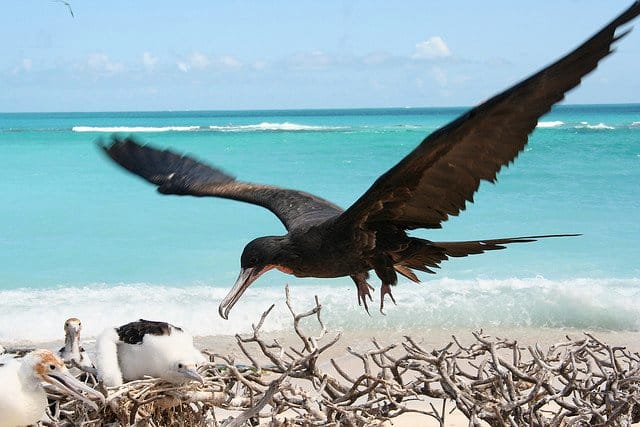 Male coming into land at nest.
Male coming into land at nest.
Frigatebirds are masters of life on the wing. So much so that their short legs are useful only for perching, making them almost unable to walk. Unusually for seabirds they not only do not alight on the water but are usually unable to take off again should they accidentally do so. Seeing one of these birds ineffectually trying to take off again after ditching in the drink is quite a sad sight. Making up for their clumsiness on land and their fatal ineptness in the water is their mastery of flight.
Frigatebirds are very long winged, and combined with a very low body weight they have the highest ratio of wing area to weight of any bird. They are capable of covering great distances, perhaps like an albatross. My boss on French Frigate Shoals performed a study on their movements, catching and marking them with wing tags. From the Northwestern Hawaiian Islands these birds were regularly seen travelling to Johnston Atoll, 873 kilometres away, and one was even sighted in the Philippines.
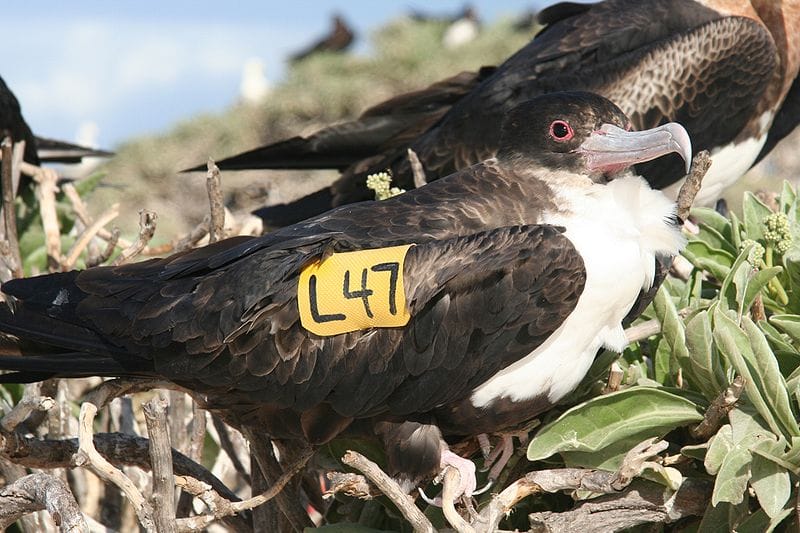 An adult female with a wingtag from the study.
An adult female with a wingtag from the study.
Unlike albatrosses, however, frigatebirds are also very manoeuvrable on the wing. This manoeuvrability is an essential aspect of their feeding, as frigatebirds get their food out of the sea without actually getting into the sea, snatching it in a similar way that pterosaurs are thought to have done so millions of years ago. Out at sea the most common prey items are flying fish, although other prey are taken particularly when pushed to the surface by hunting tuna and dolphins.
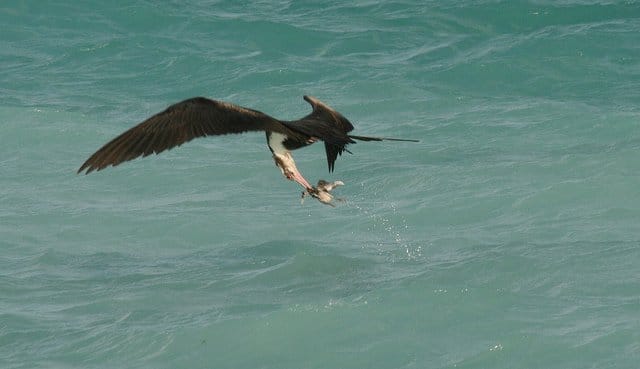 A surface snatch on the wing. The prey in this case is a tern chick dropped by another frigatebird (more on that later).
A surface snatch on the wing. The prey in this case is a tern chick dropped by another frigatebird (more on that later).
In addition to hunting their own prey all frigatebirds are famous for pursuing other seabirds and harassing them until they drop or regurgitate the food they are carrying, a feeding technique known as kleptoparasitism. Great Frigatebirds, as it happens, engage in this behaviour less often than other species, with the food obtained by piracy only accounting for about 5% of the diet of most birds. That said, it is possible to see them doing it sometimes.
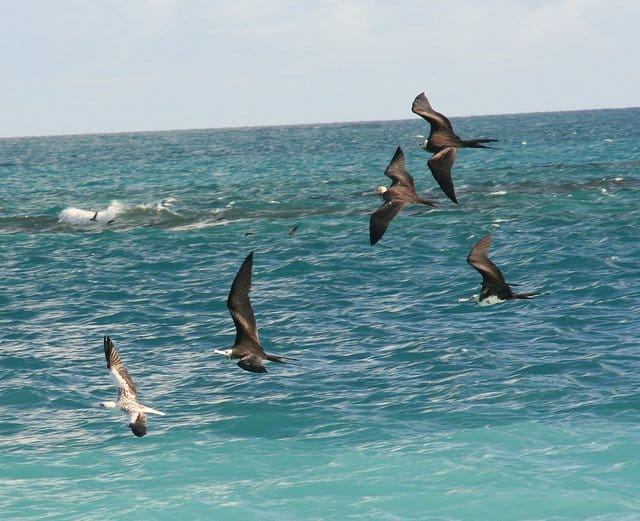 Four Great Frigatebirds harass an immature booby.
Four Great Frigatebirds harass an immature booby.
Most frigatebird feeding occurs far out at sea, but there is one type of feeding that you can’t help but notice on the islands they breed on. The same islands they breed on are important colonies for massive numbers of Sooty Terns, around 100,000 on Tern Island alone (which is barely a kilometre long and is mostly runway), as well as smaller numbers of other terns. This means there are at certain times of the year a great deal of food on the islands in small feathered packages, and a few frigatebirds engage in snatch and grab raids on the terns, snatching away the smaller chicks. Most of the birds involved in the attacks are adults females, with immatures and juveniles also hunting in this way – adult males never hunt terns. Having snatched a chick a frigatebird will itself become a target to others of its own kind, and the poor Sooty Tern chick may be dropped and snatched a number of times (often without ever hitting the ground or sea) before being swallowed whole.
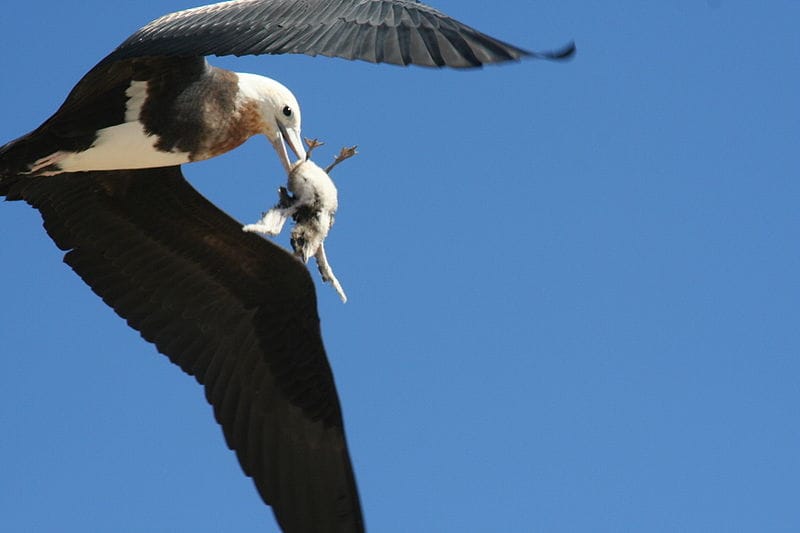 An unfortunate Sooty Tern chick snatched by an immature Great Frigatebird
An unfortunate Sooty Tern chick snatched by an immature Great Frigatebird
All this aerial wizardry takes time to develop, and Great Frigatebirds take a long time to mature. Young birds will engage in play, picking up sticks, dropping them, chasing them before they fall, and chasing other birds that carry sticks.
 Frigatebird with a stick. Pretty sure this was not nest building.
Frigatebird with a stick. Pretty sure this was not nest building.
In summary then, these are awesome birds!
 A peaceful Tern Island scene with some Red-footed Boobies.
A peaceful Tern Island scene with some Red-footed Boobies.
This post has been submitted to Bird Photography Weekly #140. Go check it out!


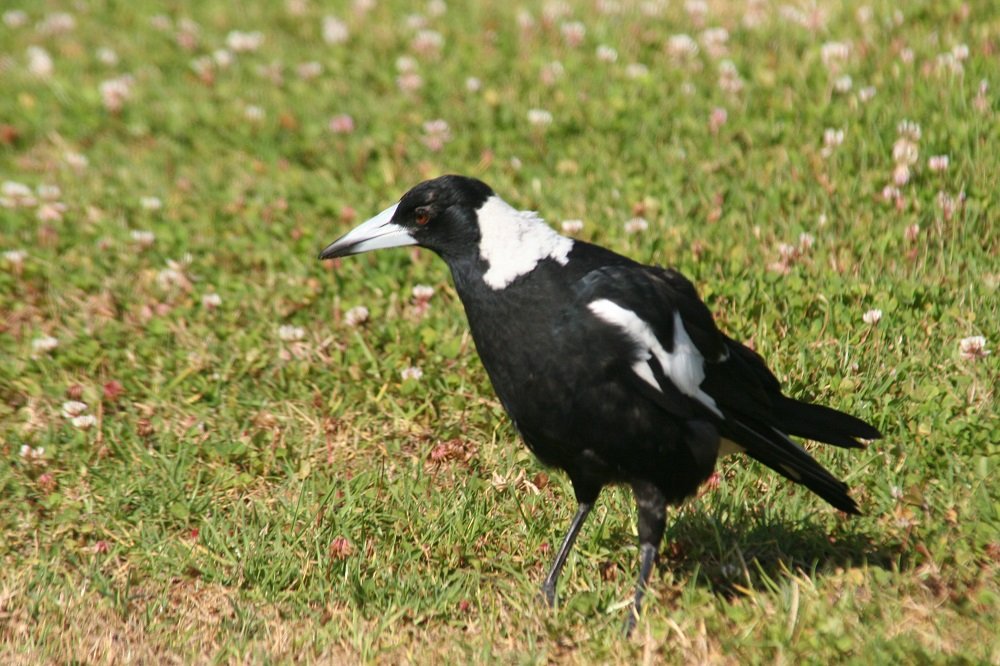

 New writers welcome – please contact us for details.
New writers welcome – please contact us for details.

















It has been a very long time since I’ve seen Frigatebirds. I’ll have to rectify that someday.
Excellent, informative article! I can just imagine the humid, salt-tinged air, hot sun reflecting off the waves, and the cacophony of tern screams when the frigatebirds snatch their chicks.
@ Pat – I have to say I’m not sure the human ear could distinguish between the cacophony of tern screams when the frigatebirds snatch their chicks and the usual workaday cacophony of tern screams. The one time I went out with them without earplugs I was genuinely disorientated after just five minutes. They are LOUD.
…wow! Incredible shots and really interesting…
Just wanted to learn about this bird while reading the old man and the sea, glad google brought me here, great info!